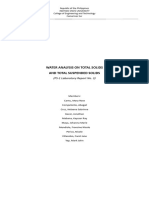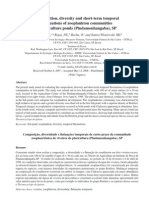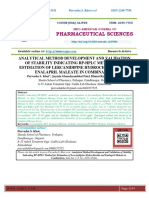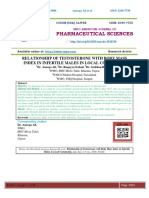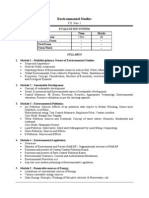9 Tamizhazhagan
9 Tamizhazhagan
Uploaded by
Baru Chandrasekhar RaoCopyright:
Available Formats
9 Tamizhazhagan
9 Tamizhazhagan
Uploaded by
Baru Chandrasekhar RaoOriginal Description:
Original Title
Copyright
Available Formats
Share this document
Did you find this document useful?
Is this content inappropriate?
Copyright:
Available Formats
9 Tamizhazhagan
9 Tamizhazhagan
Uploaded by
Baru Chandrasekhar RaoCopyright:
Available Formats
IAJPS 2016, 3 (5), 444-449
Tamizhazhagan and Pugazhendy
CODEN (USA): IAJPBB
ISSN 2349-7750
ISSN: 2349-7750
INDO AMERICAN JOURNAL OF
PHARMACEUTICAL SCIENCES
Available online at: http://www.iajps.com
Research Article
PHYSICO - CHEMICAL PARAMETERS FROM THE
MANAPPADAIYUR AND SWAMIMALAI FRESH WATER
PONDS
Tamizhazhagan V*, Pugazhendy. K
Annamalai University, Department of Zoology, Chidambaram, Cuddalore, India-608 002.
Abstract:
Aquatic ecosystem monitoring has been carried out in India based on either chemical or biological analysis.
Diatoms constitute a fundamental link between primary (autotrophic) and secondary (heterotrophic) production and
form a vital component of aquatic ecosystem. Particularly P H, Temperature, at the same time remaining parameters
of salinity, O2 and Co2 observation was slightly changed due to some pollutes. So in this study will be given
supporting to the future study among the fresh water ecosystem balance.
Key words: Physio-Chemical, Natural Pond, Culture Pond,
Corresponding author:
Dr. K. Pugazhendy,
Assistant Professor
Department of Zoology
Annamalai University
Chidambaram, India 608 002
E-mail: pugalendy@gmail.com
QR code
Please cite this article in press as Tamizhazhagan and K.Pugazhendy, Physico- Chemical Parameters from the
Manappadaiyur and Swamimalai Fresh Water Ponds, Indo Am. J. Pharm. Sci, 2016; 3(5).
www.iajps.com
Page 444
IAJPS 2016, 3 (5), 444-449
Tamizhazhagan and Pugazhendy
INTRODUCTION:
Diatoms constitute a fundamental link between
primary (autotrophic) and secondary (heterotrophic)
production and form a vital component of aquatic
ecosystem. Diatoms generally range in size from 2200m and are composed of a cell wall composed
primarily
of silica.
Diatoms
are
amazing
microscopically algae whose typical features are a
siliceous coverage, called frustules, extremely diverse
in shape. Diatoms live in almost all types of
superficial waters. Depending on their habitats,
diatoms are either planktonic (living suspended on
the water), benthic (growing associated to a
substrate), or both planktonic and benthic. The algal
species that develop in an area depend on different
environmental factors: temperature, pH, Dissolved
oxygen, Co2, salinity etc., Thus, the species that can
be found in a water body will inform about some
characteristics of the water.
Aquatic ecosystem monitoring has been carried out in
India based on either chemical or biological analysis.
The chemical approach is useful in order to
determine the levels of nutrients, metals, pesticides,
radioactive substances, etc., while the biological
approach aids in assessing the overall effect of the
chemical input on organisms. Because these
microscopic organisms depend on light and nutrients,
they populate the euphotic zone or the upper strata of
freshwater lakes, reservoirs, ponds, and rivers. Many
micro- organisms feed on diatoms and in this way
they are integrated into aquatic food webs. Diatoms
are frequently used as bio-indicators, and if they are
not investigated live they may be perceived simply as
glass boxes used to give information about water
quality. It is worth the time to study the living
communities and to note the other algae and the
interactions between the algae and other microorganisms.
Water quality is important in pond aquaculture
because water quality imbalances can cause stress,
poor growth, and mortality of culture species .Water
quality is strongly influenced by feed inputs, and
ponds with high feeding rates frequently have more
severe problems with low dissolved oxygen
concentrations and excessive concentrations of
ammonia and nitrite than ponds with low or moderate
feeding rates .Although many water quality problems
can be prevented by use of conservative feeding
practices and efficient mechanical aeration, there are
other water quality concerns in pond aquaculture.
Natural characteristics of pond waters can greatly
limit possibilities for fish culture. One naturally
occurring water quality imbalance is the case of pond
waters with high total alkalinity and low calcium
concentration. Such waters often have excessively
high pH, which can limit fish culture. Many times,
www.iajps.com
ISSN 2349-7750
site water quality limitations may be alleviated
through management, for example alleviating the
problem of high pH and low calcium by applying
calcium sulfate (gypsum) to the water to increase
calcium concentration. Moreover, some pond water
quality variables are strongly influenced by pond
bottom soil characteristics. Fish do not grow well in
ponds with acidic water, which usually are located on
acidic soils, but acidity in ponds can be corrected by
liming.
Water is an essential requirement of human and
activities development and it is one of the most
delicate part of the environment. The physicchemical properties of water and diatom have been
studied in different aquatic habitats the present study
reports on the physico-chemical properties of water
and diatoms recorded in Manappadaiyur and
Swamimalai pond situated near Thanjavur (Dt)
Tamilnadu. The aquatic ecosystem is a major
subdivision of the biosphere. Almost 71% of the
earths surface area is covered by water. In terms of
total volume of water, around 97% of the worlds
water is saline. This means that less than 3% of the
water volume in the world is actually freshwater
(Gleick, 1996). However, not all this freshwater is
readily available for use by humans and less than 1%
of is used for drinking (Grey, 1994).
There are different biological indicators that can be
used to determine the ecological status of a water
body: macro invertebrates, aquatic plants, and algae,
especially diatoms,are all used in water quality
research.
MATERIALS AND METHODS:
Description of the Study Area:
The hydrological condition of the pond water situated
near Thanjavur. The pond is situated near the east
and west Tamilnadu, India. My study area is starting
from Manappadaiyur (Nature pond) and Swamimalai
(culture pond). One of the most important features of
ponds is the presence of standing water, which
provides habitat for wetland plants and animals.
Method of Collection of Water Samples:
Water samples were collected from the fixed location
in Manappadaiyur (nature pond) and Swamimalai
culture pond at regular estimation of all the physico
chemical factors PH. The pond water temperature was
measured by Celsius thermometer. Dissolved oxygen
was determined by Winklers method as given by
Strickland and Parsons (1968). Water samples were
collected reagent bottles and fixed on the spot by
adding the reagent namely Hydrogen peroxide
followed by Hydrochloric acid and Sulphuric acid.
Carbon-di-oxide was determined with the help of
phenolphthalein indicator was present (or) absent
water samples were collection in conical flask and
Page 445
IAJPS 2016, 3 (5), 444-449
Tamizhazhagan and Pugazhendy
few drops of phenolphthalein indication if the color
turns pink, free co2 is absent, the sample titrate 0.05
N sodium hydroxide. At the end point, a pink color
appears. Then the samples we brought to the
laboratory to determine the salinity was measured by
standard methods (Body 1979 and 1995).
The correlation co-efficient was calculated
between the physical and chemical parameters of the
river using the formula,
N xy - (x) - (y)
R=
x2- (x2)- y2-(y)2
Methods of Collection of Diatom Samples:
Diatom samples were collected from the fixed
location, at nature pond water Manappadaiyur and
culture pond water Swamimalai. Diatoms can be
identified to species level though morphological
features of their frustules but these will hardly be
seen without a previous treatment consisting of
making all the organic matter disappear, leaving their
siliceous frustules empty. There are different
techniques for diatom cleaning but the hydrogen
peroxide method (30% H2 O2 solution) is the most
widely used. Firstly, if formaldehyde has been added,
it should be removed .the sample has to be
homogenized by shaking and a tube for
centrifugation has to be filled with it. Centrifuge the
sample at 2,500 rpm for 15 minutes, remove the
supernatant, refill the tube with distilled water and
homogenize it again. This process should be repeated
3 times but after the first one the supernatant must be
revised to prevent any loss of diatoms.
Once the supernatant is removed for the third time,
add a few drops of Hydrogen peroxide to the pellet.
Be careful because a lot of foam may appear! Some
more peroxide has to be added carefully until half of
the tube is filled with it. Then, the tube can be either
left covered for several days until bubbles stop
flowing (or) heated in a sand bath (or) a hotplate at
about 90C during 1 to 4 hours. In both cases, the
brownish suspension has to become whitish. After
that, add a few drops of HCL and repeat the
centrifuge process previously describe to remove all
the Hydrogen peroxide.
When diatoms are cleaned and suspended in water,
dispense a few drops of this water on a cover slip and
let it dry. Once dried, examine the cover slip under
the microscope to ensure that diatoms can be easy to
count. A good number of valves are eight per field
but it depends on their size and shape. If there are too
many, the sample must be diluted; if there are only
few diatoms, add more drops and let the cover slip
dry again. If there are not enough diatom on the cover
slip but there is too much inorganic matter on it, the
www.iajps.com
ISSN 2349-7750
researcher has to make a decision whether or not to
add more sample to the cover slip: the addition of
more sample would reduce the time of analysis but
diatom would be covered by more inorganic matter,
which makes the identification of species harder.
After getting an appropriated number of diatoms on
the cover slip, dispense a small drop of high
refractive medium (such as NaphraxTM) on a slide
and place the cover slip on it, making sure that
diatoms are in contact with the drop. Heat the
preparation for about one minute; some bubbles will
appear under the cover slip when the drop of high
refractive medium boils but they will disappear as the
slide cools again. Once cold, the cover slip should be
closely adhered to the slide; if not, the preparation
has to be heated again.
RESULTS AND DISCUSSION:
The observation was recorded between two stations
from Manappadaiyur and Swamimalai of pond. Study
of physic-chemical parameters correlation coefficient and diatoms are shown in table 1, 2, and 3.
The maximum water temperatures below 71F in
both two stations are same repeated value. John
Clegg (1986), reported by Water temperature is also
important when using aquatic herbicides to treat plant
or algae growth. Aquatic herbicides are most
effective temperatures are between 60 and when
water 75F. The pH of water sample both stations
are recorded value of 7. A significant negative
relation between temperature and pH (r=-0.3835) has
been observed.
Dissolved oxygen concentration of water sample I,
6.77 ml/lit. Sample II, 3.38 ml/lit. The minimum
level of Dissolved oxygen 3.38 mg/lit was found in
station II which received the municipal sewage and
domestic water. The similar trend was also recorded
in pond Sone and Dalmianagar (Bihar) by Singh and
Singh (1995). A signification negative relation
between Dissolved oxygen and water temperature r=
-0.2906 has been observed and also negative relation
between Dissolved oxygen and pH r=-0.4567. The
carbon-di-oxide levels of water sample I, 2.20 mg/lit.
The negative relation between Co2 and pH r=-0.4332
and
Dissolved
oxygen
r=0.3769.
Salinity
concentration of water sample I 0.437 ppt, sample II
0.6296 ppt. Singh and Singh (1995) reported that the
higher level of salinity was due to increase in
decomposition of organic matters. A signification
negative relation between salinity and water
temperature r=-0.0017, A positive relation between
salinity and Co2 r= 0.0099.
Page 446
IAJPS 2016, 3 (5), 444-449
Tamizhazhagan and Pugazhendy
.
Table: 1
(NATURAL POND)
S.No
ISSN 2349-7750
Table : 2
(CULTURE POND)
Parameters
Value
S.No
Parameters
Value
1.
Temperature
28
1.
Temperature
28
2.
PH
2.
PH
3.
Dissolved oxygen
6.77
3.
Dissolved oxygen
3.38
4.
Co2
2.20
4.
Co2
4.4
5.
Salinity
0.4379
5.
Salinity
0.626
Table 3: Correlation Co- Efficient Observed Between Two Ponds Physico- Chemical Parameters In Pond
Water.
Parameters
Water
Temperature
PH
Dissolved
Oxygen
Co2
Water parameter
1.0000
PH
-0.3835
1.0000
Dissolved oxygen
-0.2906
-0.4567
1.0000
Co2
-0.2906
-0.4332
0.3769
1.0000
Salinity
-0.0017
0.0012
0.0054
0.0099
Salinity
1.0000
Fig1: Two Ponds Physico- Chemical Parameters in Pond Water
www.iajps.com
Page 447
IAJPS 2016, 3 (5), 444-449
Tamizhazhagan and Pugazhendy
SUMMARY AND CONCLUSION:
This is certified that the earlier findings of thus the
water temperature followed by a definite pattern and
increased during day similar observation was made
by Sing et al., (1982) in pond water. The similar
trend was also recorded in pond Sone and
Dalmianagar (Bihar) by Singh and Singh (1995)
reported that the high level of salinity was due to
increase in decomposition of organic matter.
Thirty and 53 streams in the Kathmandu Valley
(2000) and Middle Hills (199496), respectively,
were sampled in October and November during
stable flows following the monsoon. Diatoms were
collected in riffles, water samples taken for chemical
analysis, and habitat character of the stream channel,
bank and catchment assessed using river habitat
surveys. While diatoms in the Middle Hills indicate
unpolluted or only mildly enriched conditions, they
reveal pronounced eutrophication and organic
pollution in the densely populated Kathmandu
Valley.
Diatom population on which the whole aquatic life
defends directly (or) indirectly largely governed by
the interaction of a number of physic-chemical and
biological conditions and tolerance to one or more of
these conditions (Reid and Matu, 1976) diatom
behavior are observed in my study area station I & II
include. The present study source very low diatom
diversity when compared with the station-I ( nature
pond)Manappadaiyur and station-II (culture pond)
Swamimalai. The higher density of diatom were
found in station- I (nature pond) Manappadaiyur at
the lower density of diatoms were found in station-II
(culture pond) Swamimalai.
Similar observation was made by station I & II.
Particularly PH, Temperature, at the same time
remaining parameters of salinity, O2 and Co2
observation was slightly changed due to some
pollutes. So in this study will be given supporting to
the future study among the fresh water
ecosystembalace.
REFERENCES:
1.APHA, 2005. Standard methods for the
examination of waters and waste water analysis. 21th
Edn.,Washigton. D.C.
2.Bate G C, Adams.J.B and Van .Der Molen.J.S
(2002), Diatoms as Indicators of Water Quality in
South African River System, WRC Report
No.814/1/02.
3.Battarbee R W (1986), Diatom Analysis, In
Berglund B E (Ed.), Handbook of Holocene
Paleocology and Paleohydrology, pp.527-570, John
Wiley And Sons Ltd., Chichester, Great Britain.
www.iajps.com
ISSN 2349-7750
CEN, EN 13946 (2003),Water Quality Guidance
Standard for the Routine Sampling and PreTreatment of Benthic Diatoms from Rivers ,
ComiteEuropeen De Normalization, p.14, Geneva.
4.Cattaneo A, Couillard Y, Wunsam S And Courcelle
M (2004), Diatom Taxonomic And Morphological
Changes As Indicators Of Metal Pollution And
Recovery In Lac Default ( Quebec, Canada) ,
Journal Of Paleolimnology, Vol.32, No.2, pp.163175.
5.De La Rey. P .A,Taylor.J.C, Laas.A, Van
Rensburgs And Vosloo .A (2004), Determining
The Possible Application Value Of Diatoms As
Indicators Of General Water Quality: A Comparison
With SASS 5, Vol.30,No.3, pp.325-332.
6.Descy.J.Pand Coste.M (1991), A New Approach
to Water Quality Estimation Using Diatoms, Nova
Hedwiggia, Vol.64, pp.305-323.
7.Dixit.S.S,
Smol, J.P,Kingston.J.C And
Charles.D.F (1992), Diatoms: Powerful Indicators
Of Environmental Change, Environmental Science
And Technology, Vol.26, No.1, pp.23-33.
8.Eloranta P (1990), Periphytic Diatoms in the
Acidification Project Lakes, In Kauppi P, Anttila P
and Kenttamies K (Eds.), pp.985-994.
9.Eloranta P And Andersson K (1998), Diatom
Indices In Water Quality Monitoring Of Some SouthFinnish Rivers , Verhandlung International
Verelngung De Limnolgi, E Vol.26, No, 3, Pp.12131215.
10.Edlund, M. B. et al 1997. Ecology, evolution, and
systematic significance of diatom life histories. J.
Phycol. 33: 897-918.
11.Fore L and Grafe C (2002), Using Diatoms to
assess the biological condition of large rivers in
Idaho, USA, freshwater biology, vol.47, No.10,
pp.2015-2037.
12.Furnas, M. 1978. Influence of Temperature and
Cell Size On The Division Rate And Chemical
Composition
Of
The
Diatom
ChaeTocerosCurloisetumc Level. J. Exp. Mar. Biol. Ecol.
34: 97- 109.
13.Gold C, Agnes Feurtet-Mazel, Coste M and
Boudou A (2002), Field transfer of Periphytic
Diatom communities to assess short-term structural
effects of metals (Cd, Zn) in rivers, pp.3654-3664.
14.Hakansson.S (1993), Numerical Methods for the
Inference of PH Variations in Mesotrophic and
Eutrophic Lakes in Southern Sweden-A Progress
Report, Diatom Research, Vol.8, No.2, pp.349-370.
15.Hassle .G.R (1978), Some Specific Preparations:
Diatoms, In Sournia A (Ed.), Phytoplankton
Manual, UNESCO, Paris.
16.Isrentant .R And Blancke D (1986), A
Transplantation Experiment In Running Water To
Measure The Response Rate Of Diatoms To Changes
Page 448
IAJPS 2016, 3 (5), 444-449
Tamizhazhagan and Pugazhendy
In Water Quality, In Ricard M(Ed.), Proc.8th Int.
Diatom Symposium (Paris 1984),Pp.347-354, Koeltz
Scientific Books, Koenigstein.
17.Johansen J R and Sray J C (1998), A new
aerophilic
diatom
genus
based
on
NaviculakrasskeiHustedt, Diatom research, vol.13,
pp.93-101.
18.Karthick B, Mahesh M K and Ramachandra T V
(2009), Community Structure Of Epilithic Diatom
Community In River Bedthi, Karnataka And Its
Implication In Water Quality Monitoring, In
Proceedings Of National Conference On Plant
Biodiversity And Bioprospecting, P.104, University
Of Mysore, India.
19.Margalef,R. 1969. Size Of Centric Diatoms As An
Ecological In-Dicator. Mitt. Internat.Verein. Limnol.
17: 202-210.
www.iajps.com
ISSN 2349-7750
20.Narendrasingh Bhandari, 2007. Correlation study
of physic-chemical parameters and quality
Assessment of Kosi river water, Uttarakhand.
E.Journal of Chennai Vol.5, No.2 ISSN-0973-4943,
342-346 pp.
21.PriyankaTrivedi, 2010. Comparative study
seasonal variation in physic-chemical characteristics
of drinking water quality in Kanpur, India. Nature
and science 8(4).
22.Swingle, H. S. 1961. Relationships of pH of pond
waters to their suitability for fish culture. Proceedings
Pacific Scientific Congress 9 (1957), Vol. 10,
Fisheries72-75.
23.Thompson, P.1999. The response of growth and
biochemical com-position to variations in day length,
temperature, and irradiance in the marine diatom
Thalassiosirapseudonana( Bacillario-phyceae). J.
Phycol. 35: 1215-1223.
Page 449
You might also like
- Water Quality Assessment PR2 FinalDocument22 pagesWater Quality Assessment PR2 FinalPeteisaiah CopadaNo ratings yet
- MBA 4th SemDocument23 pagesMBA 4th SemNeel100% (3)
- World HungerDocument5 pagesWorld Hungerveneficus08No ratings yet
- Tamizhazhagan 4Document6 pagesTamizhazhagan 4TamizhazhaganNo ratings yet
- Physico-Chemical Characterization of Layawan River: Daryl Ann V. Cuivillas, Ma - Rio Naguit, Arnelm. CuivillasDocument7 pagesPhysico-Chemical Characterization of Layawan River: Daryl Ann V. Cuivillas, Ma - Rio Naguit, Arnelm. CuivillasIOSRjournalNo ratings yet
- Copepods From Few Freshwater Bodies of Periurban Areas of South ChennaiDocument3 pagesCopepods From Few Freshwater Bodies of Periurban Areas of South ChennaitheijesNo ratings yet
- 9 12 Assessing Water QualityDocument10 pages9 12 Assessing Water QualityQweemyah IsraelNo ratings yet
- Ethodology: Hysico-Chemical and Biological Analyses of WaterDocument35 pagesEthodology: Hysico-Chemical and Biological Analyses of WaterelezkmNo ratings yet
- Sunil Kumar Tank, R. C. Chippa. Analysis of Water Quality of Halena Block in Bharatpur AreaDocument9 pagesSunil Kumar Tank, R. C. Chippa. Analysis of Water Quality of Halena Block in Bharatpur AreaDr. Krishna N. SharmaNo ratings yet
- RephraserDocument5 pagesRephraserAnil NinamaNo ratings yet
- How DO Changes With SalinityDocument13 pagesHow DO Changes With SalinityDP ChemNo ratings yet
- PS-1 LabReport3Document5 pagesPS-1 LabReport3Carol Jane VillanoboNo ratings yet
- Papayakap Sa'yo Final Paper - Belleza, Braganza, Cabalona, IstinoDocument17 pagesPapayakap Sa'yo Final Paper - Belleza, Braganza, Cabalona, IstinoArcelle BraganzaNo ratings yet
- The Pattern of Cu Accumulation in Milkfish (Chanos Chanos) During Growth Period in Fishpond in Dukuh Tapak Tugurejo Semarang, IndonesiaDocument8 pagesThe Pattern of Cu Accumulation in Milkfish (Chanos Chanos) During Growth Period in Fishpond in Dukuh Tapak Tugurejo Semarang, IndonesiaFiki FerindraNo ratings yet
- Modification of The Oreochromis SPP Aquaculture Production Environment Using GreenhousesDocument9 pagesModification of The Oreochromis SPP Aquaculture Production Environment Using GreenhousesjaefrNo ratings yet
- Ecosystem Report DraftDocument5 pagesEcosystem Report DraftMeian TanNo ratings yet
- Ethodology: Hysico-Chemical and Biological Analyses of WaterDocument33 pagesEthodology: Hysico-Chemical and Biological Analyses of Watersneh lataNo ratings yet
- Hematological Response of Tilapia On Laundry Waste WaterDocument11 pagesHematological Response of Tilapia On Laundry Waste WaterSaya AmaroNo ratings yet
- Determination and Comparative Study of Water Quality Parameters in Shrimp Culture PondsDocument6 pagesDetermination and Comparative Study of Water Quality Parameters in Shrimp Culture PondsIJRASETPublicationsNo ratings yet
- 03 21 160503Document7 pages03 21 160503faithnicNo ratings yet
- DissertationDocument10 pagesDissertationAmit KVNo ratings yet
- Bridgeresilience SLF10 Nov 2019Document5 pagesBridgeresilience SLF10 Nov 2019Sergio LozaNo ratings yet
- Journal - Bioremediation of Aquaculture Wastewater Using Macroalga and ArtemiaDocument5 pagesJournal - Bioremediation of Aquaculture Wastewater Using Macroalga and ArtemiaLiLypuzz Buxan LilyputtNo ratings yet
- IJCRDocument7 pagesIJCRIqioo RedefiniNo ratings yet
- Physical/Chemical Monitoring: CharacteristicsDocument12 pagesPhysical/Chemical Monitoring: CharacteristicsmekelewengNo ratings yet
- An Assessment of Phytoremediation Capacity of Eichhornia Solids in Plastic Recycling Industry WastewaterDocument7 pagesAn Assessment of Phytoremediation Capacity of Eichhornia Solids in Plastic Recycling Industry WastewaterInternational Organization of Scientific Research (IOSR)No ratings yet
- Marine BenthosDocument23 pagesMarine BenthosDrMumtaz F MusaliarNo ratings yet
- Water 08 00423Document14 pagesWater 08 00423Robert F GreenNo ratings yet
- The Effects of Recirculating Aquaculture System Effluent Water On The Growth of Moina Macrocopa (Straus)Document8 pagesThe Effects of Recirculating Aquaculture System Effluent Water On The Growth of Moina Macrocopa (Straus)nicko.arya.dharmaNo ratings yet
- ID Kualitas Kimia Dan Fisik Air Minum PedesDocument8 pagesID Kualitas Kimia Dan Fisik Air Minum PedesYulia NovitaNo ratings yet
- Display Board ShietsDocument11 pagesDisplay Board ShietsMi MoNo ratings yet
- Effects of Dimethoate (EC 30%) On Gill Morphology, Oxygen Consumption and Serum Electrolyte Levels of Common Carp, Cyprinus Carpio (Linn)Document7 pagesEffects of Dimethoate (EC 30%) On Gill Morphology, Oxygen Consumption and Serum Electrolyte Levels of Common Carp, Cyprinus Carpio (Linn)Amin MojiriNo ratings yet
- Study of Seasonal Water Quality Assessment and Fish Pond Conservation in Thanjavur, Tamil Nadu, IndiaDocument7 pagesStudy of Seasonal Water Quality Assessment and Fish Pond Conservation in Thanjavur, Tamil Nadu, IndiaJain KasparNo ratings yet
- Associations of Water Quality and Bacteria Presence in Cage C - 2016 - AquacultuDocument9 pagesAssociations of Water Quality and Bacteria Presence in Cage C - 2016 - AquacultuCuong DoanNo ratings yet
- Water Quality and Physiological Parameters of Common Carp Fingerling Fed On Jerusalem Artichoke TubersDocument16 pagesWater Quality and Physiological Parameters of Common Carp Fingerling Fed On Jerusalem Artichoke Tubersdaniel cretuNo ratings yet
- Sugar Mill Effluent Induced Histological Changes in Kidney of Channa PunctatusDocument4 pagesSugar Mill Effluent Induced Histological Changes in Kidney of Channa PunctatusKanhiya MahourNo ratings yet
- PracticalDocument8 pagesPracticalUfrah ShaikhNo ratings yet
- Nutrients Chap 12Document16 pagesNutrients Chap 12amaliaslavescuNo ratings yet
- Fish Diversity and Hydrological Parameters of Indrasagar Reservoir (Khandwa District)Document5 pagesFish Diversity and Hydrological Parameters of Indrasagar Reservoir (Khandwa District)International Journal of Innovative Science and Research TechnologyNo ratings yet
- J Environ Monit 13 614aDocument17 pagesJ Environ Monit 13 614akawsirislam1No ratings yet
- 2010 WastewatertreatmentDocument5 pages2010 WastewatertreatmentomkarNo ratings yet
- Assessment of The Efficiency of Duckweed (Lemna Gibba) in Wastewater TreatmentDocument7 pagesAssessment of The Efficiency of Duckweed (Lemna Gibba) in Wastewater TreatmentSandip AjmireNo ratings yet
- Growth of Spirulina Maxima Algae in Effluents Fkom Secondary Waste-Water Treatment PlantsDocument16 pagesGrowth of Spirulina Maxima Algae in Effluents Fkom Secondary Waste-Water Treatment PlantsJose RuizNo ratings yet
- Composition, Diversity and Short Term Temporal Fluctuations of Zooplankton CommunitiesDocument10 pagesComposition, Diversity and Short Term Temporal Fluctuations of Zooplankton CommunitiesLouize FonsecaNo ratings yet
- Research Journal of Pharmaceutical, Biological and Chemical SciencesDocument7 pagesResearch Journal of Pharmaceutical, Biological and Chemical SciencesSoeharti IsnainiNo ratings yet
- Research Paper Biological Assessment of Water Pollution Using Periphyton Productivity and Standing Crop in The Linggi River, MalaysiaDocument33 pagesResearch Paper Biological Assessment of Water Pollution Using Periphyton Productivity and Standing Crop in The Linggi River, MalaysiaAnkush BhartiNo ratings yet
- Name: Form: Territory: Guyana Teacher: Theme: Topic:: ObjectivesDocument4 pagesName: Form: Territory: Guyana Teacher: Theme: Topic:: ObjectivesSherida GibbsNo ratings yet
- Issue02b 09 2021Document16 pagesIssue02b 09 2021Vane NavarreteNo ratings yet
- Studies On Increasing Organic Load and Its Effect On The Survival of Selected Protozoans in The Syama Kunda, MathuraDocument3 pagesStudies On Increasing Organic Load and Its Effect On The Survival of Selected Protozoans in The Syama Kunda, MathuraSSR-IIJLS JournalNo ratings yet
- 631-Article Text-1155-2-10-20220923Document10 pages631-Article Text-1155-2-10-20220923Juliet Leslie BaquilodNo ratings yet
- 2.isca RJRS 2014 1222Document7 pages2.isca RJRS 2014 1222Zineb ALLOULINo ratings yet
- Effects of Fish Size and Biofiltration Techniques On Water Quality and Nitrogen Removal Efficiency in Recirculating Aquaculture SystemsDocument11 pagesEffects of Fish Size and Biofiltration Techniques On Water Quality and Nitrogen Removal Efficiency in Recirculating Aquaculture Systemsrahma apriantyNo ratings yet
- The Use of Some Plants in Water Purification: January 2012Document6 pagesThe Use of Some Plants in Water Purification: January 2012Gene Leonard FloresNo ratings yet
- The Use of Some Plants in Water Purification: January 2012Document6 pagesThe Use of Some Plants in Water Purification: January 2012Gene Leonard FloresNo ratings yet
- q005p107 2Document10 pagesq005p107 2imamtritriNo ratings yet
- Water Quality Classification of Quitinday Underground River Based Upon The Standards Set by The DENRDocument55 pagesWater Quality Classification of Quitinday Underground River Based Upon The Standards Set by The DENRRose Dane Escobedo DiestaNo ratings yet
- Suitability Assessment of Groundwater For Drinking and Irrigation UseDocument8 pagesSuitability Assessment of Groundwater For Drinking and Irrigation UseIOSRjournalNo ratings yet
- Reader Fish Full Draft XDocument20 pagesReader Fish Full Draft Xapi-247656145No ratings yet
- Water SamplingDocument21 pagesWater Samplingouie dolbaNo ratings yet
- A Case Study of Physico-Chemical and Bacteriological Analysis of Ajnal River at Harda M P During Monsoon SeasonDocument4 pagesA Case Study of Physico-Chemical and Bacteriological Analysis of Ajnal River at Harda M P During Monsoon SeasonEditor IJTSRDNo ratings yet
- Water Pollution ControlFrom EverandWater Pollution ControlSuresh T. NesaratnamNo ratings yet
- Aquaponics Systems, Fish. Volume 6: Sistemas de acuaponíaFrom EverandAquaponics Systems, Fish. Volume 6: Sistemas de acuaponíaNo ratings yet
- Development and Validation of Stability Indicating Assay Method For Estimation of Teriflunomide in Tablet Dosage FormDocument11 pagesDevelopment and Validation of Stability Indicating Assay Method For Estimation of Teriflunomide in Tablet Dosage FormBaru Chandrasekhar RaoNo ratings yet
- Analytical Method Development and Validation of Stability Indicating RP-HPLC Method For Estimation of Lercanidipine Hydrochloride and Enalapril Maleate in CombinationDocument8 pagesAnalytical Method Development and Validation of Stability Indicating RP-HPLC Method For Estimation of Lercanidipine Hydrochloride and Enalapril Maleate in CombinationBaru Chandrasekhar RaoNo ratings yet
- Knowledge On Antibiotics Use and Its Storage Among Saudi Arabia Residents: A Cross Sectional StudyDocument8 pagesKnowledge On Antibiotics Use and Its Storage Among Saudi Arabia Residents: A Cross Sectional StudyBaru Chandrasekhar RaoNo ratings yet
- Relationship of Testosterone With Body Mass Index in Infertile Males in Local CommunityDocument4 pagesRelationship of Testosterone With Body Mass Index in Infertile Males in Local CommunityBaru Chandrasekhar RaoNo ratings yet
- Gastroprotective Activity of Methanolic Extract of Phyllanthus Acidus Fruit Against Indomethacin-Induced Gastric Ulcers in RatsDocument7 pagesGastroprotective Activity of Methanolic Extract of Phyllanthus Acidus Fruit Against Indomethacin-Induced Gastric Ulcers in RatsBaru Chandrasekhar RaoNo ratings yet
- A Brief Review On YawsDocument7 pagesA Brief Review On YawsBaru Chandrasekhar RaoNo ratings yet
- Descriptive Study Knowing The Patients Load in The Neonatal Icu at The Tertiary Care Hospital LahoreDocument4 pagesDescriptive Study Knowing The Patients Load in The Neonatal Icu at The Tertiary Care Hospital LahoreBaru Chandrasekhar RaoNo ratings yet
- Pharmaceutical Sciences: IAJPS 2018, 05 (04), 3075-3081 Aneeqa Ali RaoDocument7 pagesPharmaceutical Sciences: IAJPS 2018, 05 (04), 3075-3081 Aneeqa Ali RaoBaru Chandrasekhar RaoNo ratings yet
- Review On: Inventory ManagementDocument8 pagesReview On: Inventory ManagementBaru Chandrasekhar RaoNo ratings yet
- Assessment of Correlation Between Physical Activity and Academic Performance Among The Students of Gujranwala Medical College, GujranwalaDocument7 pagesAssessment of Correlation Between Physical Activity and Academic Performance Among The Students of Gujranwala Medical College, GujranwalaBaru Chandrasekhar RaoNo ratings yet
- Determination of Bioactive Compounds From Piper Nigrum L by Using Ft-Ir Spectroscopic AnalysisDocument3 pagesDetermination of Bioactive Compounds From Piper Nigrum L by Using Ft-Ir Spectroscopic AnalysisBaru Chandrasekhar RaoNo ratings yet
- The Role of Clinical Pharmacist in Pharmacovigilance and Drug Safety in Teritiary Care Teaching HospitalDocument11 pagesThe Role of Clinical Pharmacist in Pharmacovigilance and Drug Safety in Teritiary Care Teaching HospitalBaru Chandrasekhar RaoNo ratings yet
- Pharmacological and Phytochemical Evidence of Scutia Genus Plants - A ReviewDocument7 pagesPharmacological and Phytochemical Evidence of Scutia Genus Plants - A ReviewBaru Chandrasekhar RaoNo ratings yet
- DISTINCTIVE PHARMACOLOGICAL ACTIVITIES OF Eclipta Alba AND IT'S COUMESTAN WEDELOLACTONEDocument7 pagesDISTINCTIVE PHARMACOLOGICAL ACTIVITIES OF Eclipta Alba AND IT'S COUMESTAN WEDELOLACTONEBaru Chandrasekhar RaoNo ratings yet
- Determination of Bioactive Compounds From Piper Longum L. by Using HP-LC AnalysisDocument4 pagesDetermination of Bioactive Compounds From Piper Longum L. by Using HP-LC AnalysisBaru Chandrasekhar RaoNo ratings yet
- STUDIES ON QUALITATIVE PHYTOCHEMICAL ANALYSIS AND ANTIBACTERIAL ACTIVITY OF Piper NigrumDocument7 pagesSTUDIES ON QUALITATIVE PHYTOCHEMICAL ANALYSIS AND ANTIBACTERIAL ACTIVITY OF Piper NigrumBaru Chandrasekhar RaoNo ratings yet
- RP-HPLC Method Development and Validation of Alogliptin Bulk and Tablet Dosage FormDocument8 pagesRP-HPLC Method Development and Validation of Alogliptin Bulk and Tablet Dosage FormBaru Chandrasekhar RaoNo ratings yet
- DETERMINATION OF BIOACTIVE COMPOUNDS FROM Piper Nigrum. L BY USING HPLC ANALYSISDocument3 pagesDETERMINATION OF BIOACTIVE COMPOUNDS FROM Piper Nigrum. L BY USING HPLC ANALYSISBaru Chandrasekhar RaoNo ratings yet
- (S7Lt-Iid-4) : Legend: Problem Solving Information Literacy Critical ThinkingDocument1 page(S7Lt-Iid-4) : Legend: Problem Solving Information Literacy Critical ThinkingRaniel LacuarinNo ratings yet
- UNIT-I Fundamentals of Environmental SciencesDocument10 pagesUNIT-I Fundamentals of Environmental Sciences11007886No ratings yet
- Organic Aquaculture-A New Approach in Fisheries DevelopmentDocument19 pagesOrganic Aquaculture-A New Approach in Fisheries Developmentmrd4856No ratings yet
- Care and Maintenance MungbeanDocument16 pagesCare and Maintenance MungbeanJohn JamesNo ratings yet
- Environment Engineering and Health Safety (FET-1311) Lecturer 1Document19 pagesEnvironment Engineering and Health Safety (FET-1311) Lecturer 1Muhibullah MuhibNo ratings yet
- Just Energy TransitionDocument12 pagesJust Energy TransitionRusdy WahidNo ratings yet
- 2015 Mains Gs4 Question No.01 SolvedDocument2 pages2015 Mains Gs4 Question No.01 SolvedadiNo ratings yet
- Visit To National Zoological Park: Submitted byDocument17 pagesVisit To National Zoological Park: Submitted byHimanshi ManglaNo ratings yet
- Managing The Miombo Woodlands of Southern AfricaDocument77 pagesManaging The Miombo Woodlands of Southern AfricaProgram on Forests100% (1)
- 0510 0993 FOA OTG ScriptB P1Document16 pages0510 0993 FOA OTG ScriptB P1Ugana BaaskaNo ratings yet
- Cover Letter Examples ZoologistDocument7 pagesCover Letter Examples Zoologistafiwhlkrm100% (2)
- Poster ThesisDocument1 pagePoster ThesisShaira Jean SollanoNo ratings yet
- Landscape Design Report - Part 01Document17 pagesLandscape Design Report - Part 01عرباض لطیفNo ratings yet
- Biodyne Organic World Congress India 2017 IssueDocument9 pagesBiodyne Organic World Congress India 2017 IssuesdoctorNo ratings yet
- 2011.PHYSIS.J.marine - Science.v.9.cited in This Issue of The Journal: Ostroumov SA (2005) Some Aspects of Water Filtering Activity of Filter-Feeders - HTTP://WWW - Scribd.com/doc/54500338Document92 pages2011.PHYSIS.J.marine - Science.v.9.cited in This Issue of The Journal: Ostroumov SA (2005) Some Aspects of Water Filtering Activity of Filter-Feeders - HTTP://WWW - Scribd.com/doc/54500338Sergei OstroumovNo ratings yet
- Product Catalog IPLDocument28 pagesProduct Catalog IPLtellashokNo ratings yet
- Humid Subtropics Permaculture Design ExerciseDocument44 pagesHumid Subtropics Permaculture Design ExerciseHeloisa Dinsmore100% (1)
- Case Study Sustainable MiningDocument15 pagesCase Study Sustainable MiningShiv Prasad SawNo ratings yet
- No Net Land Take by 2050 FB14 enDocument16 pagesNo Net Land Take by 2050 FB14 encork_ieNo ratings yet
- Environmental AssignmentDocument5 pagesEnvironmental AssignmentAlbert Francisco OstayaNo ratings yet
- Surugiu Et Al. (2021) A Hotspot in The Romanian BlackDocument9 pagesSurugiu Et Al. (2021) A Hotspot in The Romanian BlackVictor SurugiuNo ratings yet
- Activity 4-BORREDocument4 pagesActivity 4-BORRELara Mae Felizardo BorreNo ratings yet
- Rocky and Sandy ShoreDocument12 pagesRocky and Sandy ShoreStephanie Jane AndoyNo ratings yet
- Environmental Sci SyllabusDocument6 pagesEnvironmental Sci SyllabusTine MendozaNo ratings yet
- Choi - 2016 - More-Than-Human Geographies of Nature Toward A Careful Political EcologyDocument20 pagesChoi - 2016 - More-Than-Human Geographies of Nature Toward A Careful Political EcologyAsterija JubileeNo ratings yet
- Introduction FWM Prospectus 2021Document13 pagesIntroduction FWM Prospectus 2021syed MoazzamNo ratings yet
- Environmental StudiesDocument2 pagesEnvironmental Studiesapi-236544093No ratings yet
- ABSTRACTS The Ecological Society of America 88thannual MeetingDocument398 pagesABSTRACTS The Ecological Society of America 88thannual MeetingYendra PratamaTerrificninetyninefoldNo ratings yet











